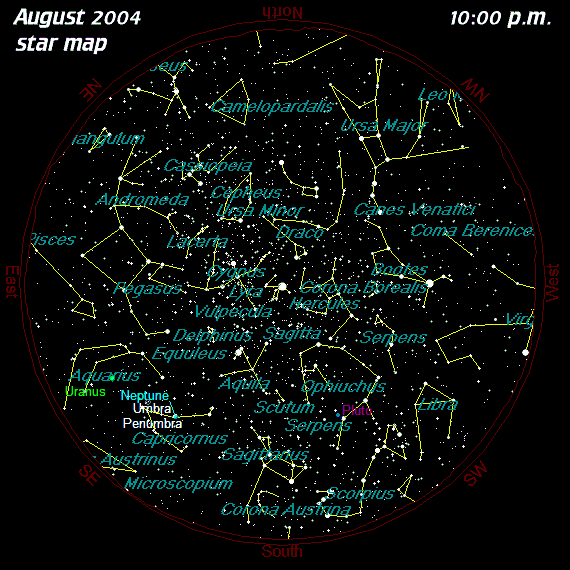



![[Moon Phases]](../moonphases/2004-08-phases.jpg) |
|---|
![]()
![[Perseid Meteor Shower]](8-04-perseids.gif) |
|---|
| Perseid Meteors should be plentiful on the morning of August 12. Look NE starting around midnight or earlier on August 11 to catch the year's most popular meteor display. Perseid meteors should be plentiful all week. Graphics by Gary A. Becker... |
![[Star Hill Thunder]](8-04-shi-thunder.jpg) |
|---|
| The summer monsoons often bring thunder to the Sangre de Cristo Mountains in New Mexico by noon and clear skies by 3 a.m. This July 20th storm was rumbling by 11 a.m., but it passed to our south. Photo by Gary A. Becker... |
![[Star Hill Inn Milky Way]](8-04-shi-milky-way.jpg) |
|---|
| Summer Milky Way: This 8-minute guided digital image of the Milky Way was taken from Star Hill Inn near Sapello, New Mexico on July 15. Notice the expanding hub of our galaxy (center right to lower right) showing that we are far from the center of this system. Gary A. Becker photo... |
![[Star Hill Inn Milky Way enlarged]](8-04-shi-milky-way-lg.jpg) |
|---|
| The summer Milky Way just north of Sagittarius holds a rich variety of celestial wonders to observe with telescopes or binoculars. The designation “M” in the digital star field stands for Messier, in honor of Charles Messier, the French astronomer, who formulated a late 18th catalog of these objects to avoid mistaking them for comets for which he was actively searching. Gary A. Becker photo at Star Hill Inn, Sapello, NM… |
![[Star Hill Inn Dawn]](8-04-shi-dawn.jpg) |
|---|
| Day dawns at Star Hill Inn, an astronomer’s retreat in the Rockies. Above the pine tree to the left is the cup of the Little Dipper. The North Star lies high above the middle pine, and Dubhe, one of the two Pointer Stars of the Big Dipper lies low and just to the right of the middle pine. Gary A. Becker digital photo, Sapello, NM… |
![[Muhlenberg Robotic Observatory]](8-04-muhlenberg-telescope.jpg) |
|---|
| North meets South: Dr. Robert Milligan (left), Muhlenberg College Physics Dept. Chair meets for the first time with John Shobbrook of Coonabarabran, New South Wales, Australia in Allentown, August 23. The pair, with the help of a NASA grant, orchestrated the Muhlenberg Robotic Telescope Observatory in New South Wales that will be used for student research and will be also be made available to local school districts. Large photo, Gary A. Becker, insets, John Shobbrook/Muhlenberg College... |
![[Venus meets Saturn]](9-04-venus-saturn.jpg) |
|---|
| Venus passes Saturn: Venus is the brightest object in this 5:15 a.m. digital photo taken on September 1 from Coopersburg, PA. Saturn is immediately above and to the left of Venus. The other stars in the photograph are part of winter constellations that will be dominating the sky in February 2005. See the map which can be found below this picture. Gary A. Becker photo… |
![[Venus at Dawn]](8-04-venus-saturn.gif) |
|---|
![[Venus at Dawn]](8-04-venus.jpg) |
|---|
| Venus Reigns: The bluing towards the bottom left of this six-minute digital image announces the dawning of a new day at Star Hill Inn near Sapello, New Mexico. Venus reigns in the lower right of the picture. Above it is yellowish Aldebaran in Taurus the Bull, and the Pleiades star cluster. The bright star on the left is Capella of Auriga the Charioteer. Gary A. Becker digital photo, July 21, 2004... |
 |
